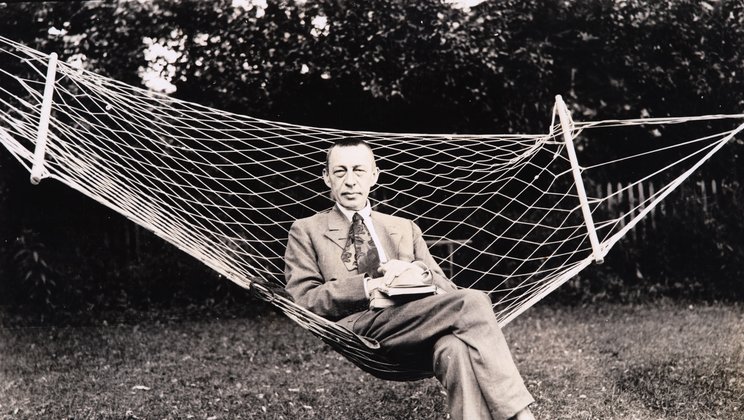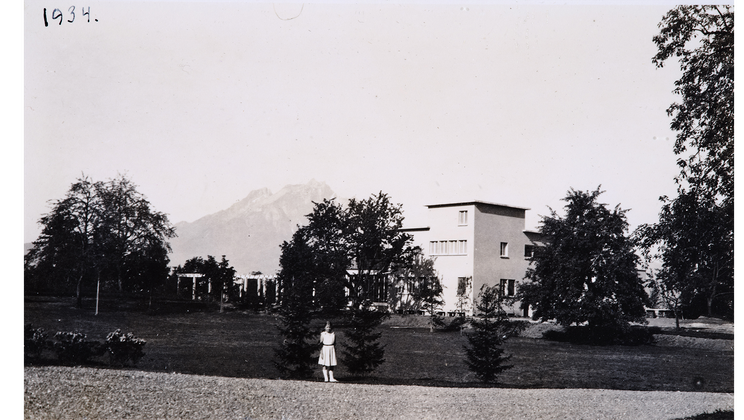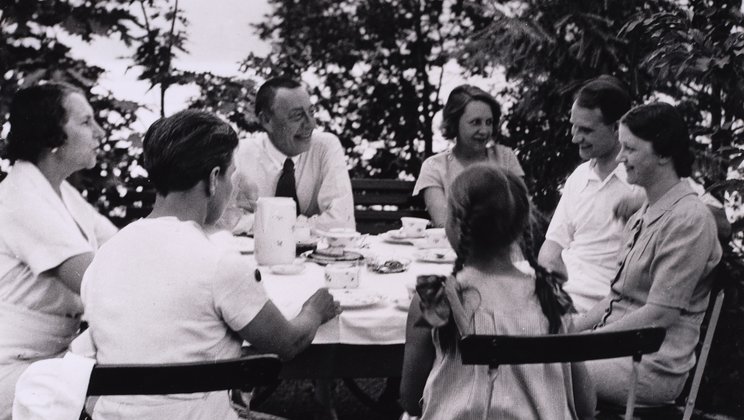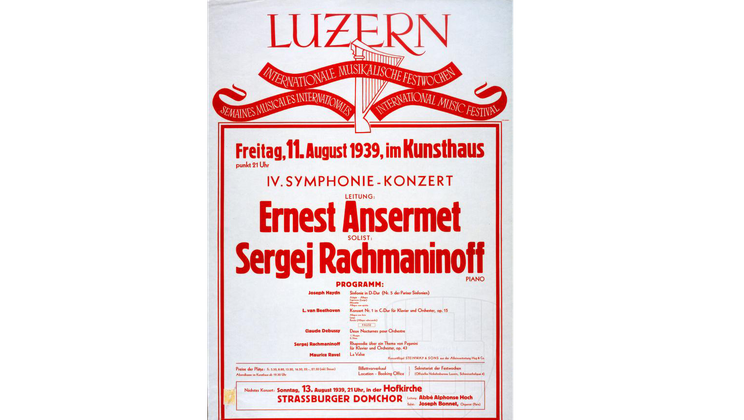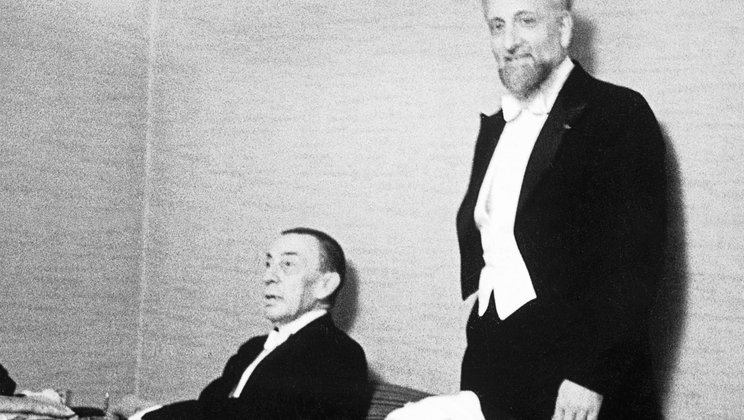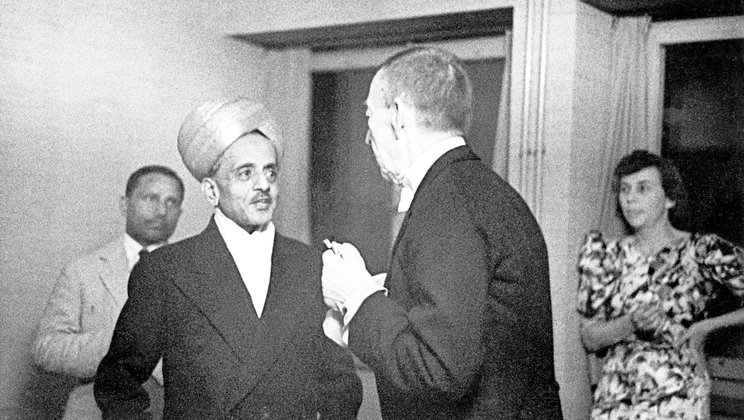The William Tell of Villa Senar: Sergei Rachmaninoff in Lucerne
On 1 April 2023, the world celebrated Sergei Rachmaninoff’s 150th birthday. It’s a good occasion to recall the Lucerne connections of the Russian composer and pianist – he even resided in the region for a time. And that’s no April Fool’s joke.
If you get on board a motorboat in front of the KKL Lucerne (Rachmaninoff himself owned one), you can make it to Hertenstein in just under a quarter of an hour. There, on the shores of Lake Lucerne, in the 1930s Rachmaninoff arranged for a rocky ledge to be blown up so as to even out the surface to build a luxurious villa on the site. He had fled the turmoil of war and revolution in his native Russia in 1917, making his way to the USA by a roundabout route. In exile, he worked primarily as a pianist – especially to earn a livelihood for himself and his family – and as a result was constantly on tour, with hardly any time left to compose.
This situation changed only at the end of the 1920s, when the Rachmaninoffs decided to again settle in Europe – at least during the summer months – and purchased a piece of land in Hertenstein, a peninsula near Lucerne that juts far out into the lake. Rachmaninoff wrote in a letter that he felt “wonderful” even though he could “so far only dream of the big house. Here is just the silence and tranquility that I need so much.” He added: “I think I’ve found the place where, when the time comes, I should be buried.”
An Idyllic Country Estate in Bauhaus Style
In order to be able to build on their plot of land, it initially had to be leveled – thus the need to blast away the rocky surface. Rachmaninoff rejected a more traditional design by Emil Felix, a Swiss architect based in Cologne, who wanted to redesign and expand on the existing chalet. Instead, he commissioned the Lucerne-based architects Alfred Möri and Karl Friedrich Krebs – representatives of the “new building” movement who also had the Lukaskirche next to Lucerne’s Vögeligärtli built almost at the same time. From 1931 to 1934, they constructed the surprisingly modern villa he had requested: in Bauhaus style, with light colors, flat roofs for sunbathing, and large glass walls facing the lake and the mountain panorama. It also featured oil heating, an elevator, and a garage for the Lincoln purchased by Rachmaninoff, who loved driving his car. The composer even acquired a motorboat to take joyrides on Lake Lucerne. (It was so powerful that later, during World War II, the Swiss Army added the boat to its reserves.) The “finest room,” according to Rachmaninoff’s plans from the start, was to be his studio: “three and a half to four meters high, with large windows overlooking the lake,” and equipped with a concert grand piano from Steinway & Sons that was 1 meter longer than usual and specially produced for Rachmaninoff’s 60th birthday.
When he walked through his new house, he felt “like a millionaire – even if not every millionaire owns such a house,” Rachmaninoff observed. He proudly repeated a remark his chauffeur once made: “You could charge admission for the view alone.” Rachmaninoff also lavished special attention on the park he had designed on the nearly 20,000-square-meter property, which even included a gardener’s lodge along with a boathouse and a bathhouse. He planted cypress, larch, silver fir, birch, maple, tulip, and plum trees, rose hedges, and weeping willows. In fact, he even helped out with the planting himself, directing a farmer who was at work with a horse-drawn plow on the grounds, and noted on the day of the ceremonial opening of Hertenstein: “I walked through the garden to check all the trees.” All of this showed how preoccupied he was to use modern technology so as to approximate the lifestyle of the pre-revolutionary Russian landed gentry of the sort he himself had long ago enjoyed on his wife’s estate, Ivanovka, in his former homeland.
A Renewal of Creative Energy in Switzerland
Rachmaninoff chose the name “Senar” for his villa on Lake Lucerne, incorporating his and his wife’s first names: Sergei and Natalya Rachmaninoff. He signed his letters “William Tell of Villa Senar.” For seven years, from 1932 to 1939, he spent the summer months here with his family. And indeed, in the tranquility of his Swiss retreat, Rachmaninoff finally found his way back to composing. It was here that he wrote the Rhapsody on a Theme of Paganini, Op. 43, which became one of his best-loved scores (the Lucerne Festival Orchestra will perform the piece on 16 August 2023 with pianist Beatrice Rana). (Jokingly referring to the high cost of having his Hertenstein home constructed, Rachmaninoff called it “a little way to pay off all the foolishness I allowed myself when building the Villa Senar”). And it was here that he composed the Third Symphony, with which Riccardo Chailly and the Lucerne Festival Orchestra in 2019 launched the grand Rachmaninoff cycle.
Incidentally, Rachmaninoff personally introduced his Paganini Rhapsody to the Lucerne Festival audience. In the summer of 1939, one year after the Lucerne International Music Festival was founded (today’s Lucerne Festival), he also performed Beethoven’s First Piano Concerto together with what was then called the Festival Orchestra under the baton of the Swiss conductor Ernest Ansermet. In its review of the concert, the Neue Zürcher Zeitung praised “the stupendous lightness of his technique, his enchantingly delicate touch, and the transparency of his performance,” concluding that Rachmaninoff had “earned the love of the masses despite his dignified reserve.”
His performance also enraptured the music-loving Maharajah of Mysore, who attended the concert with his 43-person entourage and asked to be received by Rachmaninoff at Villa Senar. Rachmaninoff complied with this request and even tested the piano skills of one of the daughters of the Maharajah, who himself had once flirted with a career as a concert pianist (a choice that of course would have been unthinkable for an heir to the throne).
The concert on 11 August 1939 was to be Rachmaninoff’s only appearance at Lucerne Festival – and it was his final appearance in Europe. Just 12 days later, he set sail for America to escape the Second World War, which began a week later with Nazi Germany’s invasion of Poland. Once again, Rachmaninoff had to give up a place he called home with his departure form Villa Senar.
This home can soon be visited by all Rachmaninoff fans and music lovers. Following its use first by Rachmaninoff’s youngest daughter Tatjana and later by her son Alexander Conus, both of whom lived at Villa Senar, it was taken over by the Canton of Lucerne after Conus died and will function as a cultural center and a place for artists to gather. Along with the Wagner Villa in Tribschen, this is another inspiring site where the history of Lucerne as a city of music can be experienced.
Malte Lohmann | Editorial (translated by Thomas May)
-
Sat 01.04.Duo Igudesman & JooDate and Venue
Sat 01.04. | 18.30 | KKL Luzern, Concert HallProgram
“Happy Birthday, Sergei Rachmaninoff!” with Special Guest Yuja WangKanton Luzern und Swisslos - Mit Unterstützung vom Kanton Luzern und SwisslosSpring Festivalstarting at CHF 30 -
Wed 16.08.Lucerne Festival Orchestra 4
Lucerne Festival Orchestra | Andrés Orozco-Estrada | Beatrice Rana
Date and Venue
Wed 16.08. | 19.30 | Nr. 231304 | KKL Luzern, Concert HallProgram
Rachmaninoff | BerliozKühne-Stiftung - Main Sponsor and Partner Lucerne Festival OrchestraSummer Festival 2023starting at CHF 40
